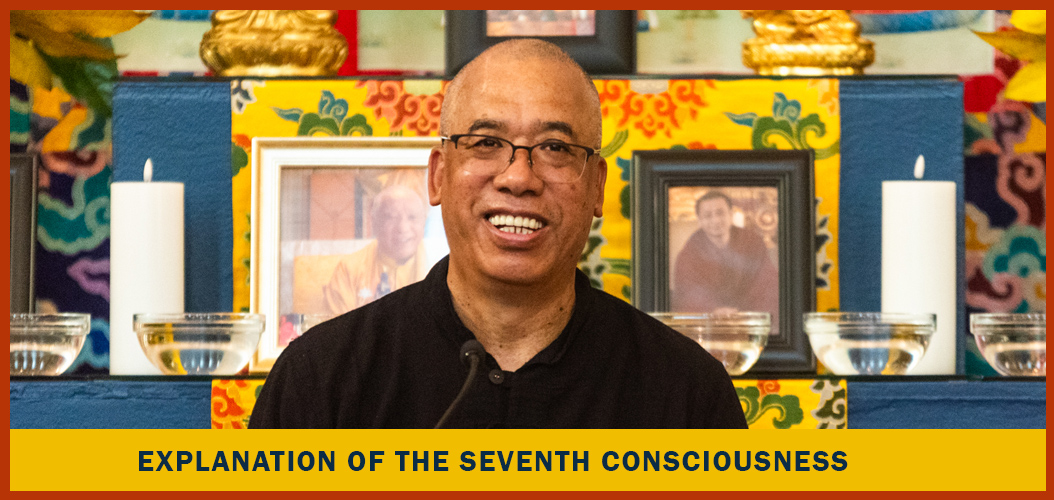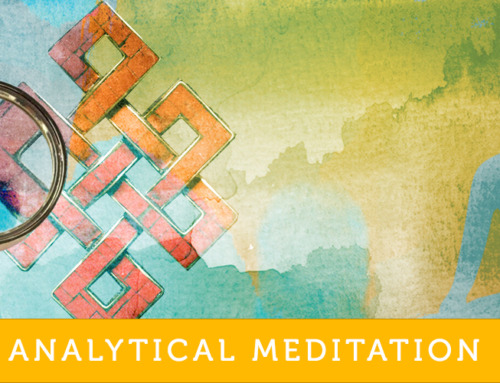This excerpt is copyrighted material, please do not use or copy without written permission from Nitartha Publications.
The following is an excerpt from 2008 Commentary on Mind Only Tenet System by Acharya Lama Tenpa Gyaltsen. This is included in the section, Ways Of Asserting Perceiving Minds III, of the sourcebook we use in our Cittamatra course.
Some topics we learn about in details in the course are:
- Distinctions of the greater and lesser vehicles
- Mind only scriptural sources, definition
- The meaning of the term “mind only,” examples
- Mind only school reasonings
- Real aspectarians and false aspectarians
- Presentation of the three natures
- Definition of mind; self-awareness
- All-base consciousness; immediate mind and klesha mind
- Transformation of consciousness into five wisdoms and three kayas
EXPLANATION OF THE SEVENTH CONSCIOUSNESS
Acharya Lama Tenpa Gyaltsen
The third Karmapa Rangjung Dorjé says that affliction is one potential feature of the seventh consciousness, but not all aspects of the seventh consciousness are afflicted. There are other aspects as well. Therefore, when we name this consciousness as a general category, we should refer to it as manas, or yi in Tibetan.
The seventh consciousness simply refers to the conceptual capacity of mind. It is the basis for all further conceptions that join names and objects. The seventh consciousness itself is not the coarse form of consciousness that join names and objects, but it is the subtle potential that gives rise to all conceptions that join names and objects. Therefore, it seems that the seventh mind is synonymous with conception in this way in the Mind Only context. The seventh consciousness takes the all-base consciousness as its object and has the thought, “This is the all-base consciousness.” Actually, it cannot actually take the all-base consciousness. This thought is referred to as a primary mind, so this is an instance where a primary mind is conceptual. This is a very useful type of mind because it serves as a gateway for the planting and the arising of habitual tendencies in the all-basis.
TWO ASPECTS
The seventh mind that observes the all-bases consciousness conceptually has two aspects: one, the immediately preceding mind that it serves as the gateway for the arising and the cessation of the six engaging consciousnesses, and two, the klesha aspect. Based on its observation of the all-base consciousness, the crazy mental events come in and form fixation on the self. They take this mere observation and from it into fixation on a self.
In the Mind Only system, the six engaging consciousnesses have no continuum. As we know from our Lorik studies, which are mostly informed by the Sautrantika view, only mental direct perception is without a continuum. From the perspective of the pramana tradition, the sense perceptions have continuums: the first moment of sense perception produces the second moment, the second produces the third moment, the third produces the fourth moment, and so on. However, in the Mind Only system, even the sense consciousnesses do not have continuums. Each moment of sense consciousness arises discretely from the all-base consciousness and dissolves back into the all-base consciousness, like waves into the ocean, but they are not annihilated when they dissolve back into the all-base consciousness. The seventh mind is that which serves as the gateway for the arising of the sense consciousness from the all-base and their dissolving back into the all-base consciousness. This is a profound point because it is easy to feel like we have no connection or relationship with all-base consciousness. We might think about the first moment of sense consciousness that arose from all the all-base, but then that sense consciousness produced other sense consciousness and hundreds of thousands of moments have transpired since that first sense consciousness arose from the all-basis so very long ago. However, according to the presentation, every single moment of sense consciousness arises in an immediate way from the all-base consciousness.
In the Sautrantika system, four conditions need to be present for a perception to arise, but in the Mind Only system, only three conditions need to be present: the causal condition, the immediately preceding condition and the dominant condition. The casual condition is the all-base consciousness, the immediately preceding condition is the seventh consciousness, and the dominant condition is a sense faculty. When those three come together, a perception of an appearance can arise. In the Mind Only System, the object condition is not needed because the object is part and parcel of the habitual tendency that is ripening from the all-base consciousness. There are no external objects in the Mind Only system, so if you want a certain object, you have to plant the habitual tendency for that object, and if you make that habitual tendency powerful enough, then an appearance of that object will arise. If you do not want a certain object, you just have to get rid of the habitual tendency for perceiving that object.
We start off with the initial quality of the immediately preceding mind that it is a primary mind yet at the same time is a thought. It is a subtle thought that observes the all-base consciousness and thinks this is me, me, me, me, me, me. It is an unclear and vague type of thought, and even though it is a thought, it is a primary mind and it is an incorrect thought.
In this way, there are no continuums for the sense consciousnesses. Each moment arises from the all-base consciousness and dissolves back into the all-base consciousness. This is the immediately preceding aspect of the seventh consciousness.
Since the immediately preceding aspect is conceptual, it is accompanied by mental afflictions, and it is said that the klesha mind, the second aspect of the seventh consciousness, is always accompanied by four mental afflictions.
We start off with the initial quality of the immediately preceding mind that it is a primary mind yet at the same time is a thought. It is a subtle thought that observes the all-base consciousness and thinks this is me, me, me, me, me, me. It is an unclear and vague type of thought, and even though it is a thought, it is a primary mind and it is an incorrect thought. The all-base consciousness is not a self or a “me” or an “I.” It is the seventh consciousness that thinks of the all base consciousness as being “me” or “I.” This mere thought of “I” is not a big problem in itself because it is just a weak and vague thought, but as a primary mind, it is accompanied by the five omnipresent mental events. In addition to those five omnipresent mental events, it is also accompanied by the four root mental afflictions of desire, ignorance, pride, and the view of a self. We can reflect further on whether these four mental afflictions arise sequentially or simultaneously. It seems like they might arise sequentially, but we would have to analyze further and figure out the order in which they arise.
It is impossible for an afflicted mind to coexist with a mind of valid cognition. From the afflicted aspect of the seventh consciousness arise all conceptions, mental afflictions, and imputed nature phenomena, so it is impossible for anything arisen from the seventh mind to be a valid cognition. Furthermore, it is impossible to train the seventh mind to behave in any other way because its very essence is faulty or incorrect. Therefore, rather than the Mantrayana conception of transforming it into wisdom, the general instruction about how to relate to the afflicted aspect of the seventh mind is to relinquish it.
The seventh consciousness is transformed or relinquished in stages. Of course, we know that the seventh consciousness has two aspects, the immediately preceding aspect and the klesha aspect. The klesha aspect in turn has two aspects, the coarse or imputed aspect and the subtle or innate aspect. The coarse aspect of the klesha mind is relinquished when one attains the first bhumi. The subtle aspect of the klesha mind is relinquished at the eighth bhumi. The immediately preceding aspect of the seventh consciousness is relinquished at the state of the tenth bhumi where the all-base consciousness itself is reversed or flipped. In the dharma language of Asanga and Maitreya in Distinguishing the Middle From the Extremes and Distinguishing Dharma and Dharmata, the seventh consciousness in both its kleshas and immediately preceding aspects is called “false ideation.”
To clarify, the coarse forms are also the seventh consciousness, but when the seventh consciousness observes the all-base consciousness and has the thought of self, it is a subtle thought, not a coarse thought that mixes objects and terms. The creation of the potential for thoughts happens in the seventh consciousness on the subtle level of conception. It is what we call false ideation.
Furthermore, although the seventh consciousness perceives the entity of the all-base consciousness, but it perceives it incorrectly. If something is a primary mind, it is not necessarily a valid cognition. Within primary minds, it is possible to have both valid cognition and nonvalid cognition. In the case of both valid cognition and nonvalid cognition, the object is correct, but the difference is whether the object is correctly cognized or incorrectly cognized. The all-base consciousness is not self, but it is perceived by the seventh mind as the self, and in this way, it is incorrectly perceived by a primary mind.
With regards to the three conditions needed for the arising of an engaging consciousness: the causal condition or all-base consciousness, the immediately preceding condition or seventh mind, and the dominant condition, a sense faculty, in the Mind Only system, objects and consciousnesses are simultaneous. The reasoning of definite simultaneous observation is one of the reasonings that establish that no objects are separate from mind and that the objects of consciousnesses arise simultaneously. However, in order for them to appear simultaneously, a gateway is needed and that is the sense faculty. Furthermore, the sense faculty is form, not consciousness per se. It is just that no form is separate from consciousness, and the faculty is a subtle form that is a necessary gateway for the simultaneous arising of objects and consciousnesses. Therefore, the sense’s faculty is not something primordially established outside of mind, but it is also something established through the habitual tendencies.





